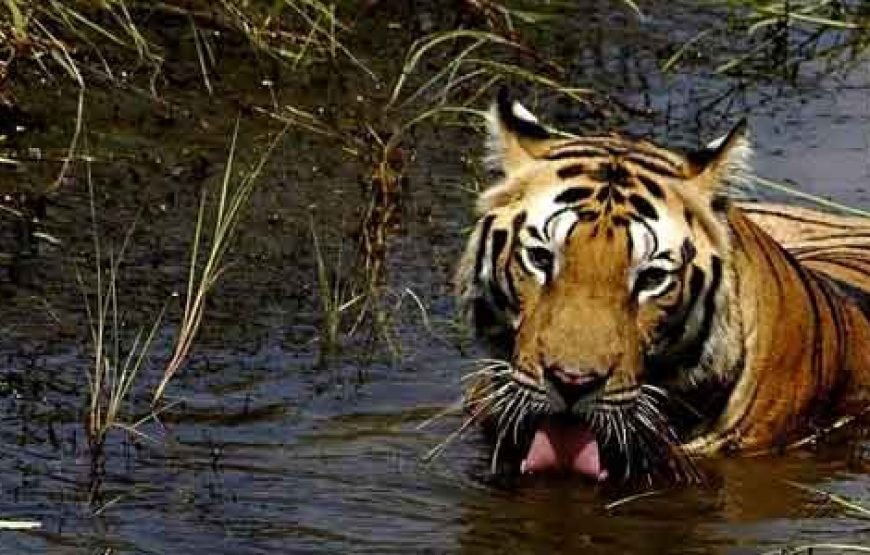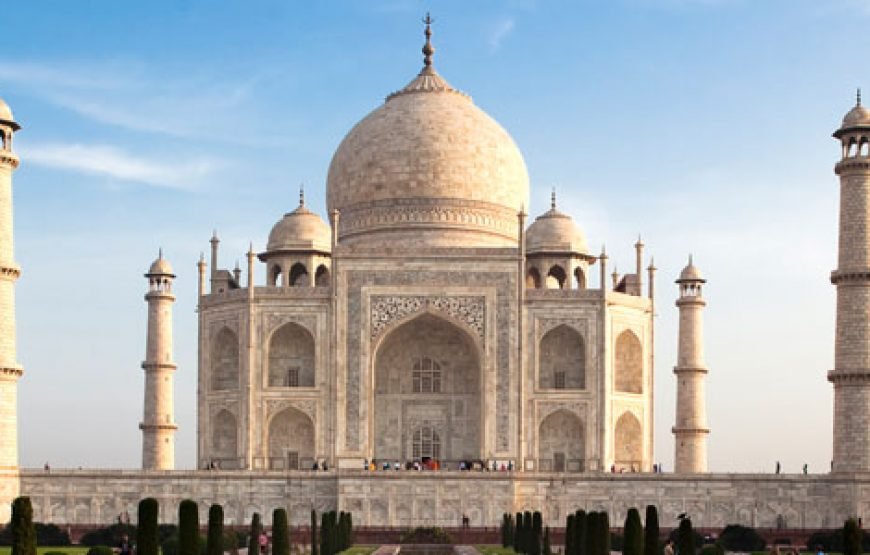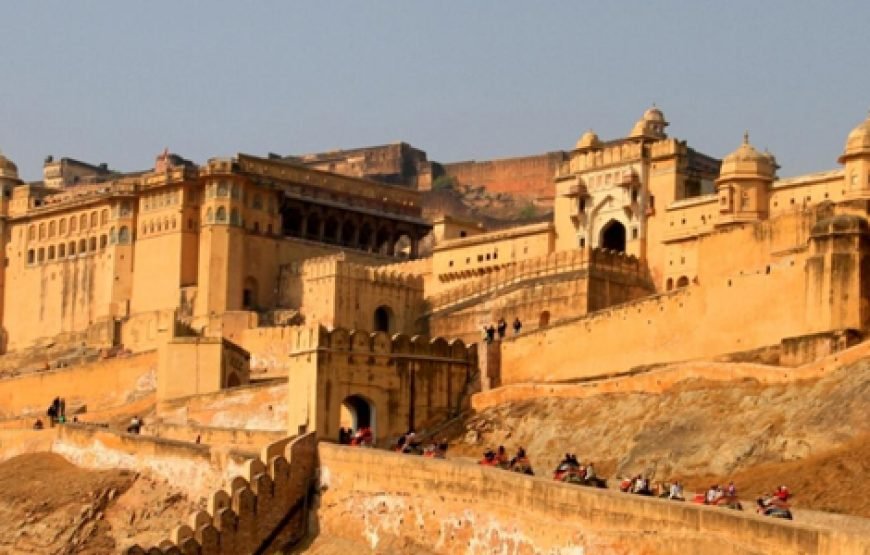from 0 review
06 NIGHTS / 07 DAYS
Daily Tour
Unlimited
___



Departure from Home Country. On arrival at Delhi, our representative will meet & greet with the traditional "Namaste" gesture-Two hands joined together in welcome-will greet them and this greeting encapsulates the warmth, hospitality and culture that makes a journey to India so memorable and transfer to Hotel (check in time 12h00- early check subject to availability) Breakfast at Hotel Later sightseeing of New Delhi visit Qutab Minar drive past India Gate and Presidential palace and parliament. Later visit old Delhi Jama Masjid (old Mosque) and also enjoy Cycle Rickshaw ride at Old Bazaar, Chandi Chowk, Rajghat and Humayun Tomb.
Delhi Diary British Colonial & 15th Century Delhi
Drive past the imposing 15th century Red Fort and Chandni Chowk - Since many of the monuments are closed for restoration we suggest not spending the time to go in. It is still worth driving by it. But check with your local guide what the latest is and decide accordingly. A ride on the wild side! (Approx. 1 hr) explore the many lanes and narrow alleyways through Old Delhi. Please Note that you will be entering extremely narrow and crowded lanes, filled with people, cows, and every kind of foot traffic. Expect to be jostled and stared at. Jama Masjid: One of the greatest mosques built by the Mughals. There is so much congestion around it that you can decide if you want to get off here or not. Located in the heart of South Delhi on the way to Qutab Minar , the Essex Farms complex is home to a multitude of activities including a restaurant, banquet halls, bowling alley, gaming Parlour and a bakery. Having been in the food business since 1943, Essex Farms opened its restaurant and banquet hall doors to its guests in 1986. The multi-cuisine Essex Village Restaurant offers Chinese, Italian, Continental and Indian food, among others to suit every flavour and taste. You will drive through the Diplomatic Enclave, the Maidan lined with palaces & Government buildings to the Presidential Palace, India Gate, and other monuments designed by Sir Edwin Lutyens (open daily). Humayun's Tomb The most important early Mughal monument in Delhi, it is an outstanding landmark in the development of Mughal style. The red sandstone and marble garden tomb set the pattern for Mughal mausoleums that culminated in the Taj at Agra. Continue your tour to visit the Qutab Minar, a soaring tower of victory commenced in AD 1199 and 10 miles south of New Delhi. In 1206, the great builder and former slave Qutab-Ud-din Aibak proclaimed himself the first Sultan of Delhi. He had been governor since 1191. This Sultanate period, under various dynasties, lasted until 1526. Originally more than its current 72.55m in height, it was also a handy minaret for the muezzin to call the faithful to the mosque. After sightseeing return to your hotel for relax. Overnight stay at Hotel.
After breakfast at hotel, proceed for Jaipur, upon arrival installation at hotel. Rest of the day free for independent activities or Visit Local animated Bazaar. Overnight stay at hotel.
After breakfast sightseeing of Amber fort with Elephant ride to ascend the fort (depending upon the availability else by jeep) and the Pink City.The Amber palace was built by the Kachhwajas when they rose in eminence and power under the Mughals. Man Singh I built it in a style to rival Mughal grandeur and opulence. Diwan-e-Aam has a double row of columns with elephant-head brackets, which had to be covered with stucco to escape the jealous eye of Jehangir. Ganesh Pol, entrance portal to inner palaces, is the most magnificent portal in Rajasthan, covered with elegant frescoes and crowned with pavilions carrying fascinating jail screens. Afternoon sightseeing of Jaipur city sightseeing includes the City Palace - Sprout in the middle of the Great historical city Jaipur lies this unique palace offering a wide range of experiences. The battle-scarred walls & turrets remind of the glorious past. In the heart of the old city is former royal residence built in a blend of the Rajasthani and Mughal styles (open until 1700 hours). Continue your visit to "Jantar Mantar", the astronomical observatory - At the entrance to the City Palace is Jantar Mantar, the 'Yantralaya' of Sawai Jai Singh II, the last great classical astronomer in India. The modernistic structures known as 'Yantras' are the unique creations of this astronomer-king designed by him and built by experts to observe the movements of sun, moon, planets and the stars. This is the largest of five observatories founded by him in 1716 AD. The others are at Delhi, Ujjain, Mathura & Varanasi. Its massive masonry instruments are of an extraordinary precision & can still be used to measure local time, the sun's declination, azimuth & altitude, the declination of fixed stars & planets & also to determine the time of an eclipse of the sun. Then comes Jaipur's signature building, the Hawa Mahal, a multi layered palace, was built by Maharaja Sawai Jai Singh II. Famous for it's beehive like structure, the Mahal is interplay of red and pink sand stone, carefully and painstakingly outlined with white borders and motifs. The palaces and forts of yesteryears, which were witness to the royal processions and splendours, are now living monuments, accepted quite naturally into the lifestyle of the people of the "Pink City". In the evening return to your hotel. Overnight stay.
After breakfast at Hotel, drive to Jaipur (180 Kms - 04 Hrs Drive). Upon arrival check in at the Hotel. On arrival check in at Hotel. Afternoon Jeep /Canter safari to the park for wild life Sighting. After safari return back to Hotel. Overnight stay at Hotel Ranthambore National Park is one of the biggest and most renowned national park in Northern India. The park is located in the Sawai Madhopur district of southeastern Rajasthan, which is about 130 km from Jaipur. Being considered as one of the famous and former hunting grounds of the Maharajas of Jaipur, today the Ranthambore National Park terrain is major wildlife tourist attraction spot that has pulled the attention of many wildlife photographers and lovers in this destination. Ranthambore National park is spread over an area of 1,334 sq km along with its nearby sanctuaries like - the Mansingh Sanctuary and the Kaila Devi Sanctuary.The park is majorly famous for its tigers and is one of the best locations in India to see the majestic predators in its natural habitat. The tigers can be easily spotted even during the day time busy at their ordinary quest- hunting and taking proper care of their young ones.
TIMING FOR PARK VISIT
MONTHS MORNING AFTERNOON
October - March 06:30 - 10:30 Hrs 14:30 - 17:50 Hrs
April - June 06:00 - 09:30 Hrs 15:30 - 18:30 Hrs
Note : Only 20 Gypsys and 20 Canters are permitted inside the park in any one safari. As a result there is a huge demand particularly for Gypsy's. It is advisable to book the Gypsys and Canters well in advance (over 75 days in advance) specially during the peak tourist season from October to March Park Closed between : 01st July till 30 September
Early morning tea/Coffee with Cookies then proceed for Jeep/canter Safari to the park for wildlife sighting. After sighting return back to hotel for breakfast. Afternoon again start another Jeep /Canter safari to the park for wild life Sighting. After safari return back to Hotel. Overnight stay at Hotel.
Early morning assistance and transfer to Sawai Madhopur railway station to board train Jan Shatabdi Exp for Bharatpur Departure 0710 Hrs / Arrival Bharatpur at 0925 Hrs. On arrival meet and drive to deserted town of Fatehpur - Fatehpur Sikri was built by the Mughal Emperor Akbar during 1564 A.D. A sonless Akbar had gone to Sikri to seek blessings of a Muslim saint Sheikh Salim Chishti. When his son was finally born, he in gratitude constructed his capital city and named it Fatehpur Sikri. Later, due to shortage of water and unrest in the north-west, Akbar had to abandon this city. It is one of the finest examples of Mughal architectural splendour at its height. Though the city is in ruins, it is a place to visit if one comes to Agra. But in real terms Fatehpur Sikri is a place where one should spend some time. The sunset over the ruins is a sight to cherish. It is perhaps the best example of the culmination of Hindu and Muslim architecture in India. The great Mosque is said to be a copy of the mosque in Mecca and has designs, derived from the Persian & Hindu architecture Upon arrival Check in at Hotel. Later visit Mehtab Bagh to see the Taj Mahal during sunset on the bank of river Yamuna from back side. Mehtab Bagh is located on the left bank of river Yamuna opposite to the Taj Mahal. The garden complex is a huge squrare measuring approximately 300m X 300m and in straight alignment with the Taj Mahal. The exevation has revealed a huge octagonal tank on the southern periphery. Overnight stay at Hotel. Agra is famous as being home to one of the Seven Wonders of the World-the Taj Mahal. The architectural splendour of the mausoleums, the fort and the palaces is a vivid remainder of the capital in the 16th and early 17th centuries. While its significance as a political centre ended with the transfer of the capital to Delhi in 1634 by Shah Jahan, its architectural wealth has secured its place on the international map. A pleasant town with comparatively slow pace, Agra is known for its superb inlay work on marble by craftsmen supposedly the descendants of those who worked under the Mughals on the Taj. The city is also famous for its carpets, gold thread embroidery and leather shoes. Agra was once the capital of the Mughal Empire
Early morning, visit the spectacular white marble mausoleum Taj Mahal (Visibility subject to weather condition) the monument of love built by Mughal Emperor Shah Jahan in sweet memory of his wife after she died in 1631. Return to hotel for breakfast. After that visit of Agra Fort - visit Agra Fort The great Mughal Emperor Akbar commissioned the construction of the Agra Fort in 1565, A.D. although additions was made till the time of his grandson Shahjahan. The forbidding exteriors of this fort hide an inner paradise then drive to Delhi, Upon arrival Delhi, transfer to Hotel or City Restaurant (cost not Included) for refreshment. After Refreshment on time assistance and transfer to International to board flight for onward destinations .